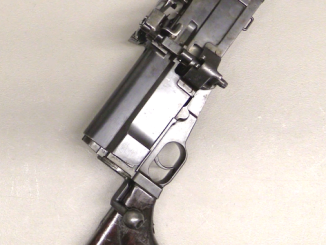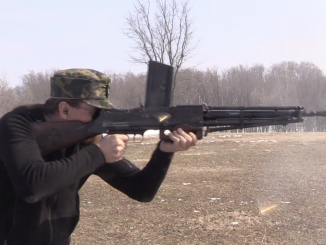Preorders now open for my book, Chassepot to FAMAS: French Military Rifles 1866-2016! Get your copy here!
As the MAS 44 saw combat service with French Marines in Indochina, some of its shortcomings began to reveal themselves. The rifle was reliable and durable, but it lacked some capabilities, most importantly rifle grenade launching and optics mounting. After a test series of MAS 44A rifles, a new pattern was adopted as the MAS 49 and put into production in 1951.
A total of about 80,000 MAS 49 rifles were made, and they incorporated a scope mounting dovetail in the left side of the receiver and a grenade launching muzzle device and sight. In addition, the bayonet was left out, as it was no longer seen as necessary. Not all rifles were used with scopes or for launching grenades, but with the universal capability it was simple to adapt any rifle to whatever specialized role was required. Ultimately the MAS 49 would be replaced again in only a few year, by the MAS 49-56 iterative improvement – but that’s a subject for a future video.




In a lot of ways, the MAS49 paralleled the German K43, and that’s not a bad thing overall.
Integral scope mount- check.
10-round detachable box magazine- check.
Pretty much ambidextrous- check.
About the same weight and overall performance as the M1 Garand- check.
There really was very little negative to be said about the M1949, and the M1949/56 pretty much took care of what few shortcomings it had. Which were more omissions (i.e., the GL) than any real fundamental design flaws.
About the only real “nice to have” thing the 49 or 49/56 could have had was a spare 15-shot magazine. Get the other guy used to you reloading after every 10 rounds, then put it in, fire ten, and when he pops up to let you have it give him the other five.
cheers
eon
“scope mounting dovetail”
Hmm… that combined with fact that MAS-49 was not super accurate (indeed its spread was tight enough as general service rifle, but not enough for very precise shots – common trait among self-loading rifle locked by tilt – like SVT-40 or FN FAL) and (in hindsight) FR F1:
https://modernfirearms.net/en/sniper-rifles/standart-caliber-rifles/france-standart-caliber-rifles/fr-f1-2/
was introduced later to give greater precision, suggest that French forces already detected need for designated marksman rifle as early as 1949. Though did that finding impacted their organization? How scoped rifles were distributed? Was scoped rifle assigned to random soldier in unit or it was assigned to one which scored best in shooting training?
As what we would today call a designated marskman’s rifle, the Mle. 49 performed admirably. The low-powered scope should clue one in that this was never intended as a precision (“sniper”) rifle.
In that role in French service, the rifle was issued to those that demonstrated marksmanship potential, i.e. those that scored the highest and showed proficiency around a rifle.
The squad marksman isn’t expected to put an entire magazine’s worth of bullets into the same bullet hole. He’s expected to be able to force the other team to duck and cover out of FEAR of getting nailed by someone they can’t even see. Machine guns are obvious threats that tell you where they are, forcing you to choose a different path to survival (including retreating through the bushes). A scoped-rifle issued to a squad marksman becomes a threat of uncertainty (since there is ONE rifle they don’t know about, even if it is just another “standard” rifle). A “proper” sniper instills complete paranoia in the enemy (you die before anyone hears the shot that kills you). The only thing worse than all of this is likely a five-hour-long artillery barrage or a thousand-heavy-bomber raid.
I could be wrong.
I’ve never been in combat. Talking about “thousand bomber raids” in light of Iraq Afghanistan and beyond seems facetious at best.
By “thousand bomber raid” I meant “destroy the city/neighborhood/mountain-range/stretch-of-highway and kill everyone in it without any mercy at all.”
All early-mid 20th Century sniper rifles were what we would now call DMRs. A specially selected and/or lightly accurised version of a standard service rifle, fitted with a scope in the 1.5-4x region. Effective range 600M. Maybe 800.
The big developments after WW2 were:
– USMC from the 60s fielding Winchester model 70 target rifles with Unertl high-power target scopes;
– US Army, having invested in the M21 (sniper M14), opting increasingly for the M40 (Rem 700);
– Soviets developing the SVD-63 in, er, 1963, because neither the SKS nor the AK could reach out effectively anywhere near 600; the SVD is every Second World War sniper’s ideal of a sniper rifle;
– the British adoption of the AI L96: a militarised match target rifle, suddenly pushing effective range to 1000, and beyond with the right cartridge/ammo and ever-increasingly powerful and high-quality optics. And to this day conceptually copied by everyone.
– the US, Brits, etc, adopting the DMR/Sharpshooter concept (typically a refined AR10 design, but conceptually an SVD) alongside both the issue rifle and the dedicated sniper rifle, issued down to section/squad level, unlike “proper” snipers that are held at company level, because they are as much as ISR asset as a weapon.
This is undoubtedly a solid and versatile rifle, arguably of greater practical value than Famas. I’d have one question of curiosity – how cleaning of gas system was conceived to be performed? Perhaps we have a person here who was in French service at the time when this rifle was issued.
“(…)greater practical value than Famas(…)”
???
https://modernfirearms.net/en/bez-rubriki-en/famas-eng/
FAMAS (excluding short version) is able to fire 22 mm grenades too. It also could be equipped with bi-pod and optical sights. Moreover it can be also equipped with 40 mm grenade launcher M203. Also taking in account it selective-fire nature it could provide greater volume of fire. Naturally as using 5,56×45 NATO cartridge it had shorter reach, but
to compensate allowing controllable full-auto fire, which MAS-49 could not due to cartridge used.
Denny–I never served in the Armee de Terre, and never had to take apart and reassemble one of these in the course of military service… So take my experiences of (mis)reading the manual in a language not my own and my own personal experiences as a collector of service rifles with a grain of salt.
My understanding, subject to the limitations above, is that the French infantry used gasoline as a solvent, and motor oil as a lubricant. This was simple, cheap, and already available. No particular training was required for the direct-impingement gas system. Such maintenance as was required may have been done at the armorer’s level.
In contrast to the silly Mosin M44 bayonet and Simonov carbine bayonet, that of the MAS Mle. 1936 bolt-action and Syrian variant of the FSA M 1949 gave the soldier so equipped a handy land mine probe…
I was over at a friends place here in France the other day and the question of guns they used during their military service came up.
The two chaps around my age 60 to 67 had the Mas 36 while my friend who is 50 had the Famas. Nobody had used the Mas 49 or 49/56 so it must have been used only by the professional soldiers
Merci! Thank you for the very interesting observation.
My MAS Mle. 1936 rifle was put away, greased and wrapped up, then put in a plastic bag, in Clermont-Ferrand in 1976. Prior to that it had been rebarreled. Initially, it had been made in 1946.
My U.S. M1 Garand similarly was made in April/May 1945, but then got a 1965 barrel put on in Red River Army Depot in Texarkana–the “two State city.” Then it got stuck in a warehouse in Alabama until the early 1990s, when I received it.